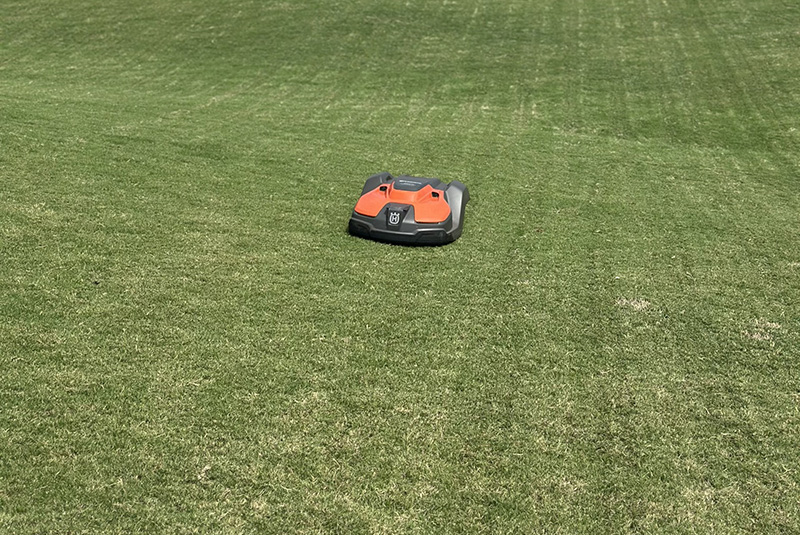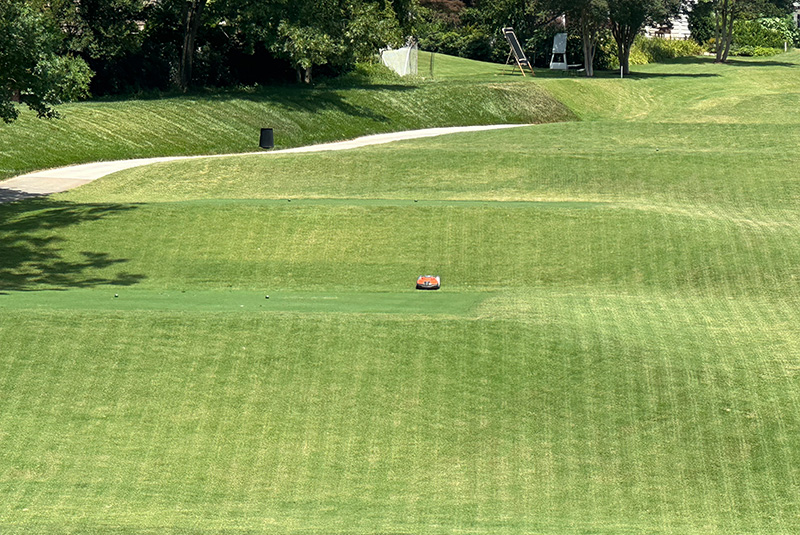
Maintenance team members at Myers Park Country Club in Charlotte, NC, have gotten a boost from Husqvarna autonomous mowers since 2023. Photos by Scott Kennon, CGCS
Editor’s note: The following article was created in partnership with Husqvarna. All product claims, research cited and other information is directly from the company.
Scott Kennon’s journey with autonomous mowers didn’t begin with golf, but with tennis.
“We have a tennis complex that covers two to three acres of area,” Kennon, CGCS and director of golf course operations at Myers Park Country Club in Charlotte, NC, says. “We couldn’t maintain the grass to the level we wanted to without impacting member experience. We were trying to cut the grass (with traditional mowers) and it was noisy, smelly, and interrupting league play. We could never find a good balance.”
In 2023, Kennon’s club purchased five Husqvarna 550 autonomous mowers to handle the tennis complex’s zoysiagrass after getting a very convincing live demonstration — they’re fortunate to have the company’s American headquarters just half an hour north. By the middle of summer, he says, “Our turf quality improved fivefold. Noise issues went away completely, we were able to get cutting heights down and clipping yield was next to nothing.”
The next step was clear: in 2024, Kennon, with the hearty support of the club, leased 22 of the Husqvarna mowers to maintain a third of Myers Park’s 100-acre Donald Ross-designed golf course. It’s only been about a year, but the mowers, which Kennon and his team primarily use on rough, have already made an impression.
“Our fertilizer inputs are down, the canopies are healthier, the clipping yields are down,” Kennon says. “The golfers are eager to experience what it’s like to play with autonomous mowers running everywhere on the course.”
Ryan Severidt, CGCS, director of golf courses & grounds at Woodmont Country Club in Rockville, Md, has been using Husqvarna’s autonomous mowers a little longer — this is the club’s third year using them.
“We started with the 550s, which we used to mow the back club lawn and areas around the short course and green surrounds close to the clubhouse,” Severidt says.
Among those areas of focus was a spot that had compacted soil from recent construction, typically a delicate situation for heavier traditional mowers, which could undo fertilization and aerification efforts to restore the turf. It turned out the lightweight Husqvarna 550s were just what they needed.
“We’ve seen huge quality gains by running these lighter mowers,” Severidt says. “It basically floats over the grass, and there’s no clippings.”

An autonomous mower tackles the no. 11 tee complex at Myers Park Country Club.
From there, it was onward and upward. “Since then, we’ve expanded our usage,” Severidt says. “In year two we started using them on bigger sections of holes and the greens around the par-threes.”
The plan, according to Severidt, is to eventually use the Husqvarna mowers to cut 100% of the course. “Certain areas grow more than others, and we put the mowers there because they cut no matter what,” he says.
Case in point: this summer, the mid-Atlantic region has been wetter than usual; Severidt says the Woodmont received nine inches of rain in May, and eight inches in July. The resulting conditions would usually cause trouble for ride-on mowers. “You don’t want to ruin what you have, so you wait and by the time you get on it, the grass is too long, and you’re affecting pace of play. We’re a busy course, so that’s a big deal.”
With the Husqvarna mowers, Severidt says, soggy turf is no longer a problem. “The rough stays the same height all the time,” he says. “The mowers are so light and versatile that they keep going. If you set the mowing height for 2.5 inches it’ll be 2.5 inches. Our members love that.”
Both Severidt and Kennon say that in addition to getting done what traditional mowers sometimes can’t, the machines also help with another persistent turf industry problem: labor shortages.
“We try to attract people, and we think we have a fun place to work, but obviously we all have labor challenges and we’re struggling to find folks who want to do this, or do it for very long,” Kennon says. “Now, we can take some of the staff who were doing maintenance in the rough and re-deploy them to do things we weren’t able to address on a regular basis. We’re talking about outer-edge areas, detail work, edging practices and spots in the native areas. We can put a guy or girl or two in those areas and work those areas a little bit more.”
“The mowers create more flexibility,” Severidt says. “If you’re down two or three people on the team, it’s not as big a deal as it was before. Usually, the people on your rough mowers or blowers, those are your better operators, so there’s a trickle down. If they’re free to do some of the other things that require more precision, that helps every level.”
It certainly helps, both men say, to have hands-on help from Husqvarna technicians. Many of the company’s account managers are former golf course superintendents with industry knowledge, and dealers service the equipment themselves.
“Service was there immediately, and extremely responsive. They got a jump on everything,” Severidt says. “Husqvarna was willing to come out and do extended demos, and willing to help us make sure everything was working properly.”
Kennon has had an even more direct experience; with the company’s headquarters so close, Myers Park has become a testing ground for new ideas. “We welcome their technicians, and the folks from Sweden come over,” Kennon says. “They learn from us, and we learn from them. They’re very responsive, I find, to challenges we may face with technology.”
With all the benefits of using Husqvarna autonomous mowers on the course, Kennon says, the future looks pretty bright. “By the time we get to the end of our leases on these mowers, we may have some staff turnover, some folks will retire, and we’ll start to fill those positions. With the efficiency these mowers create, I think the possibilities are limitless in terms of what we can fill them for.”
Abby Olcese is GCM's online editor